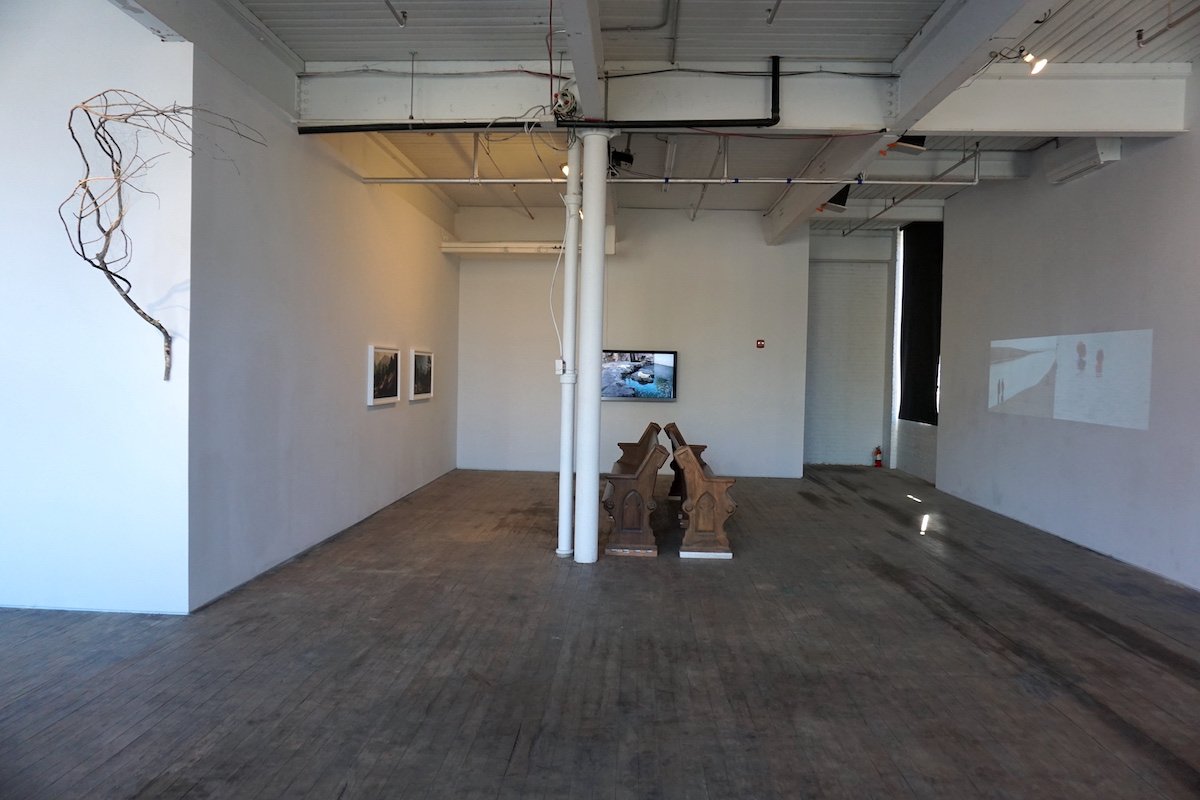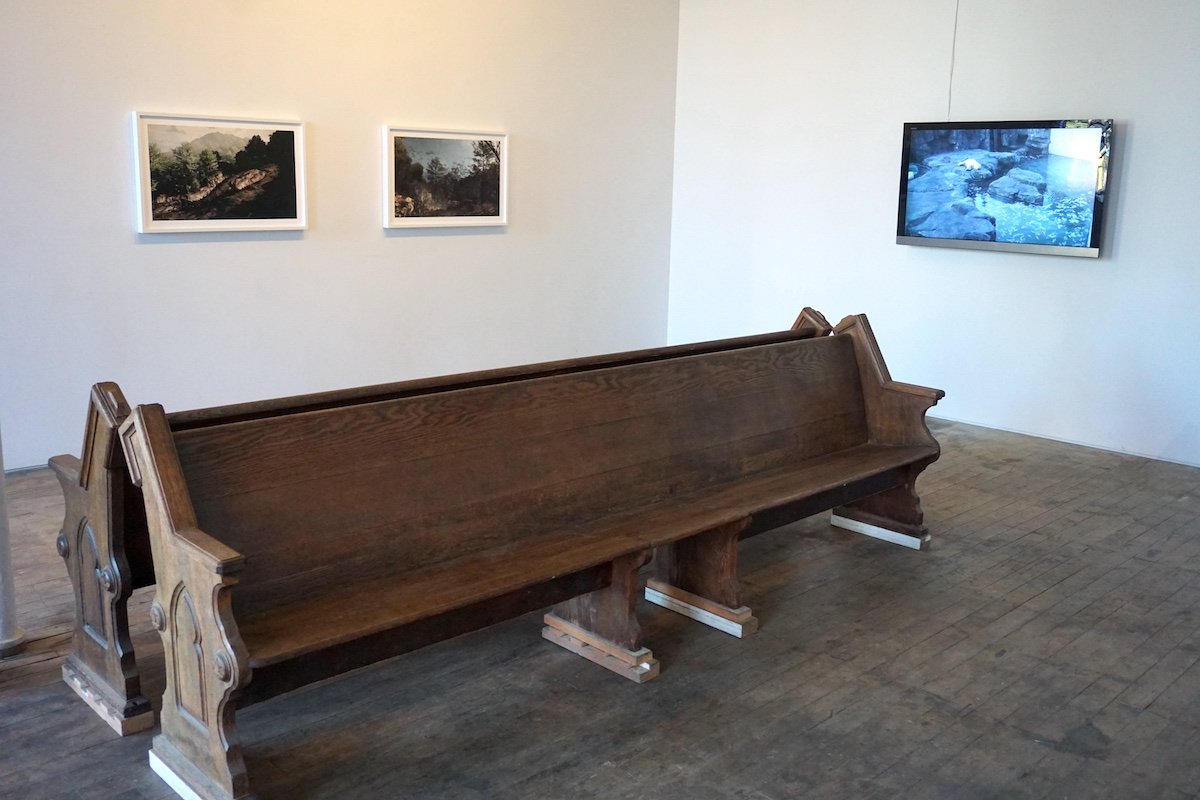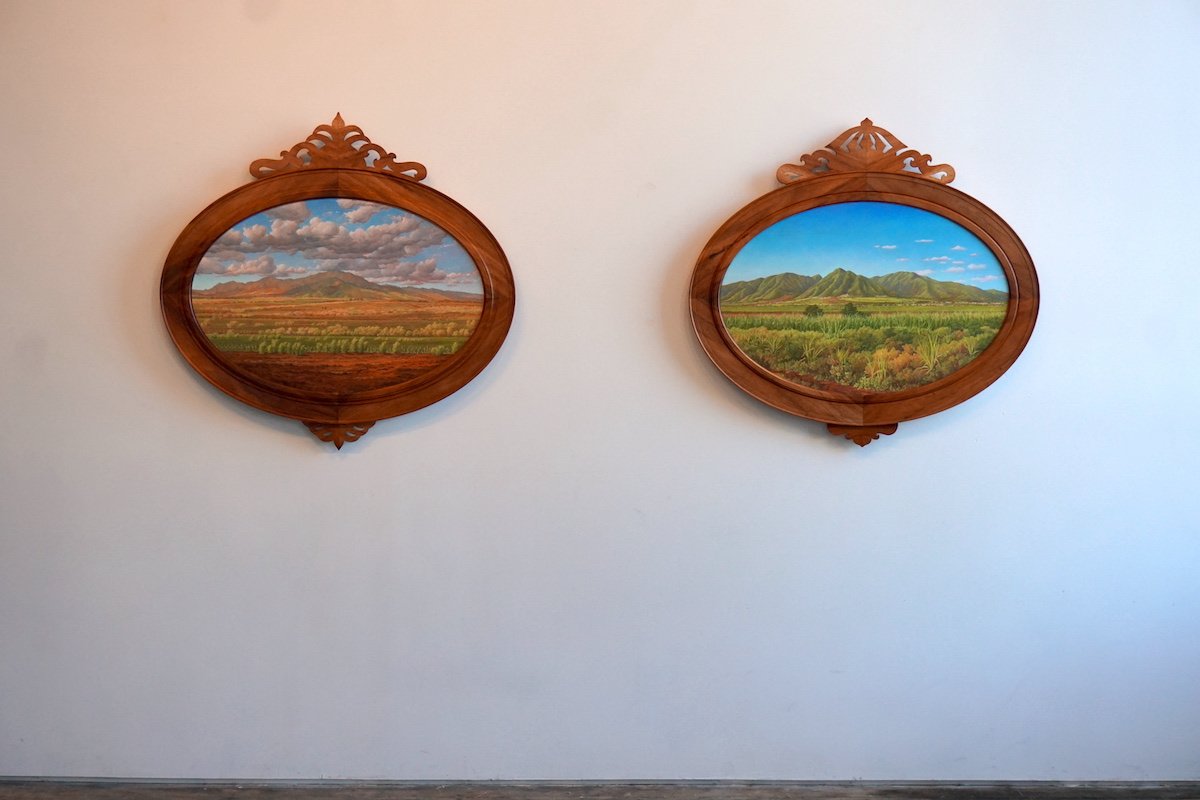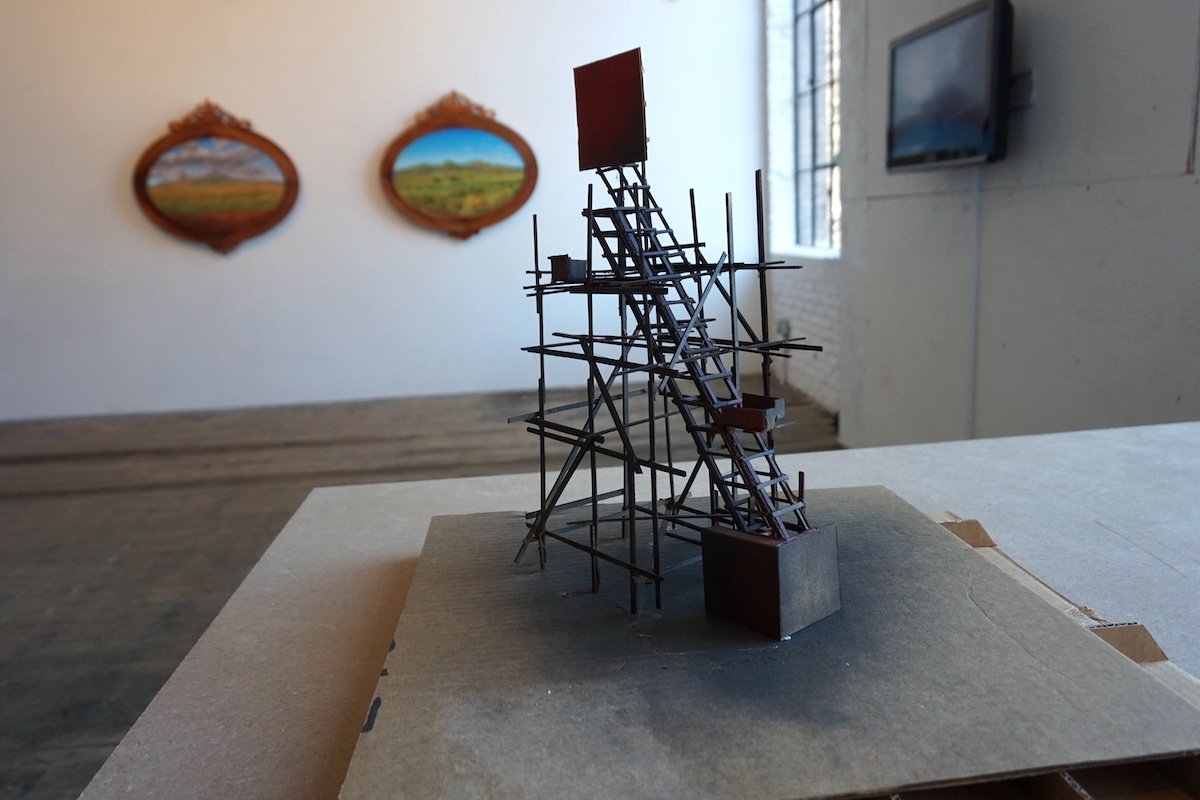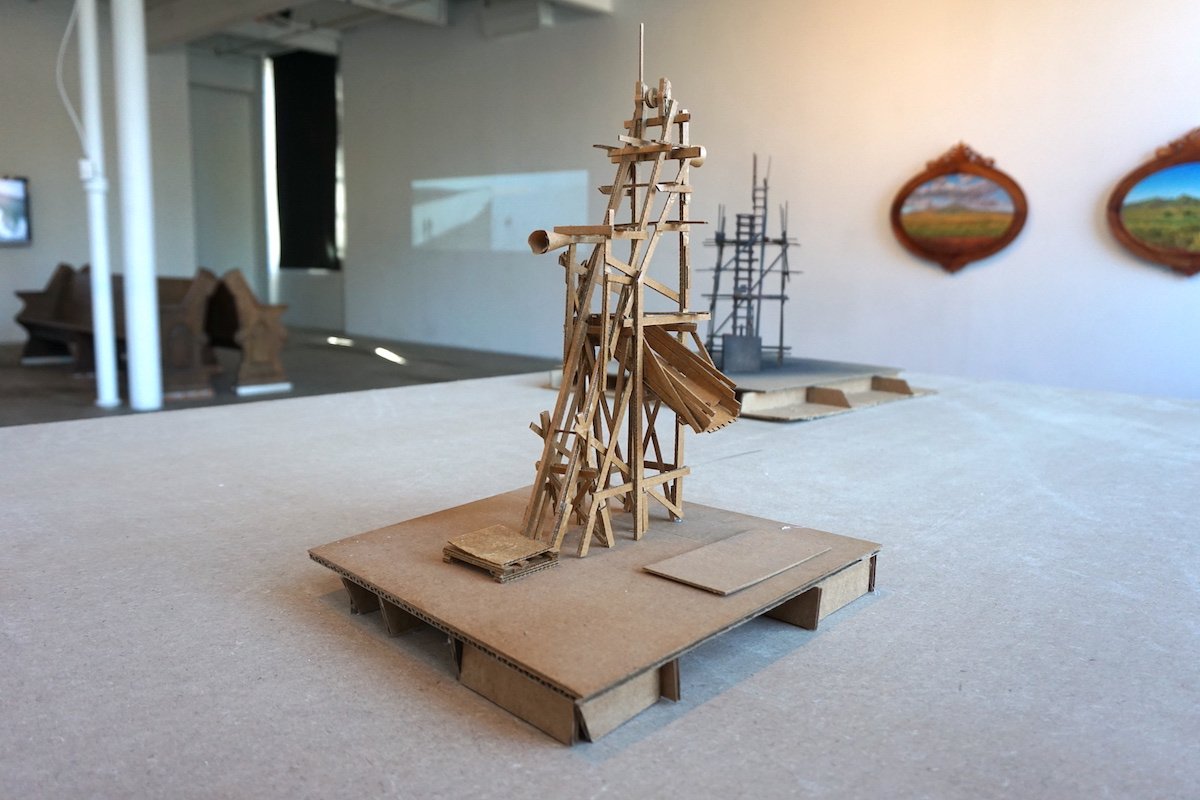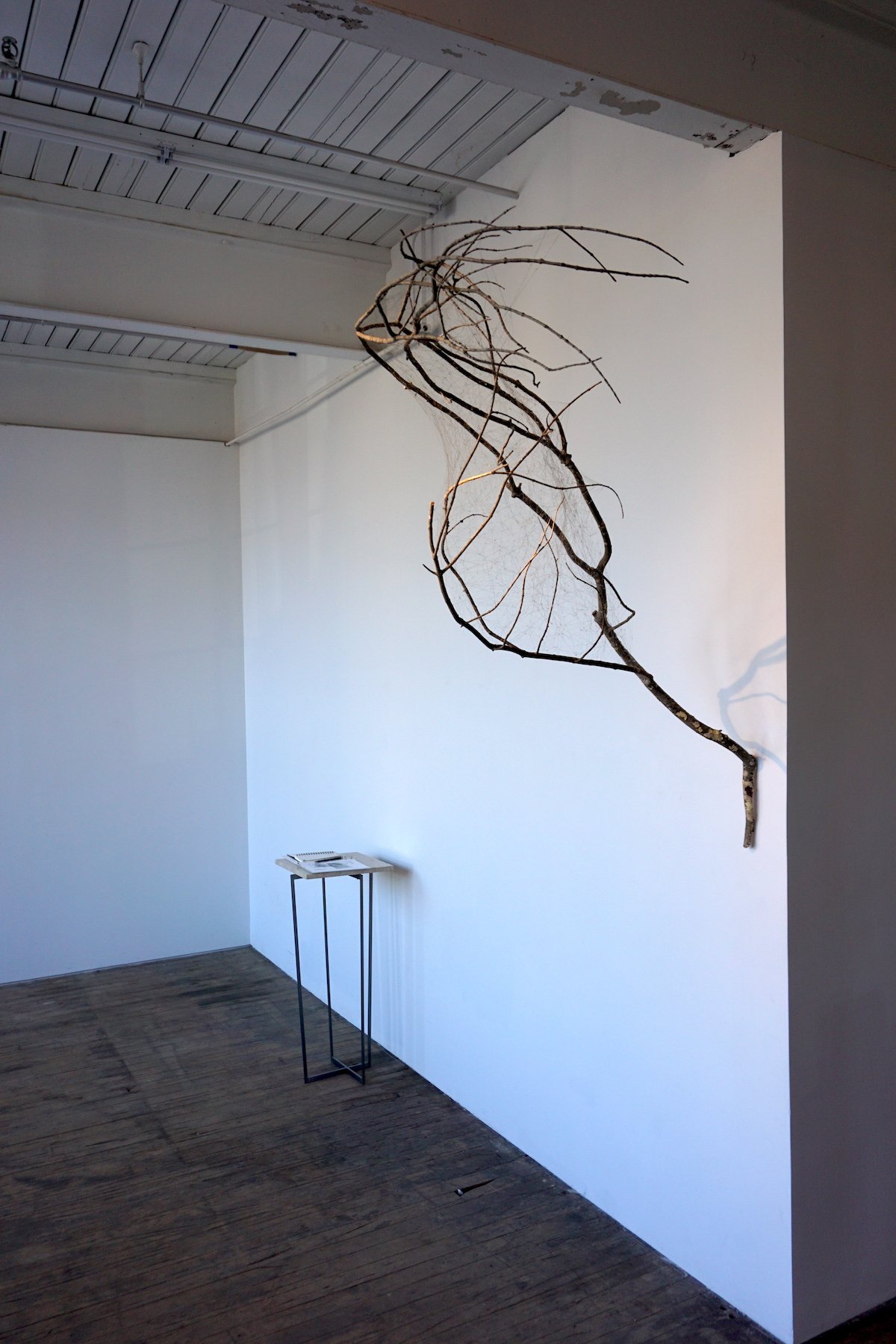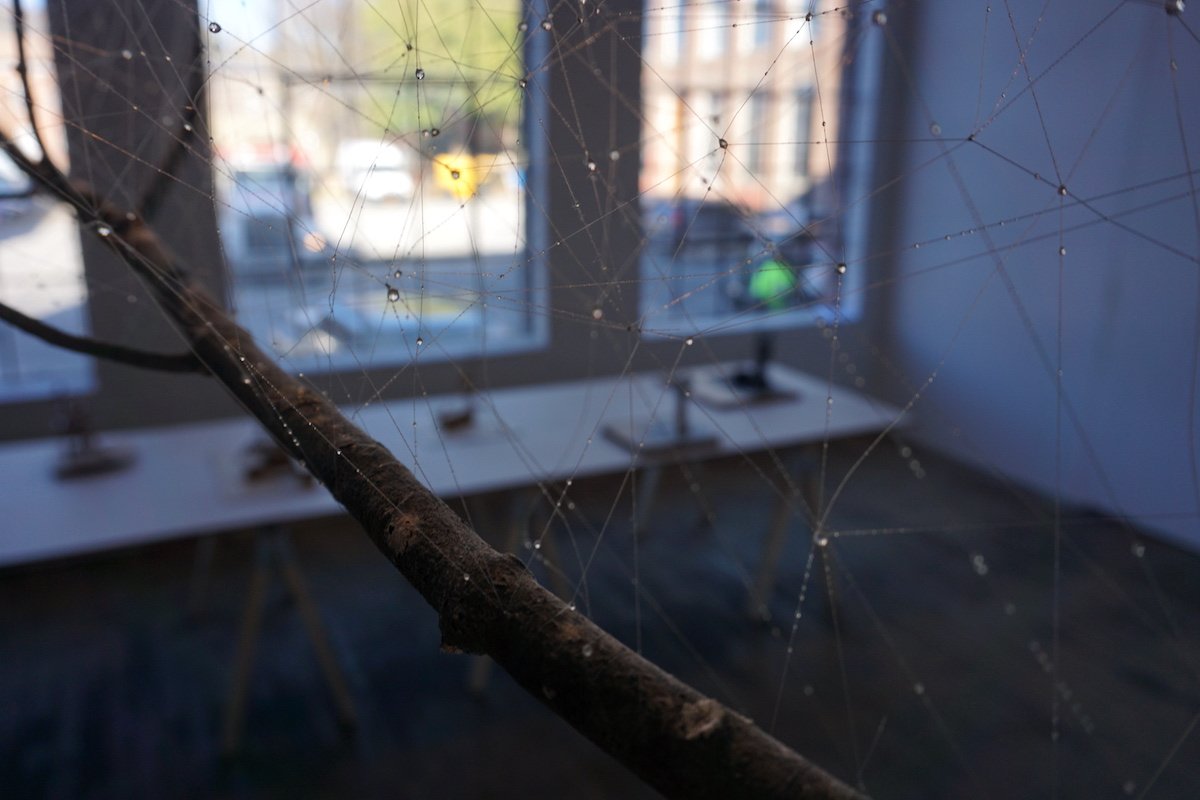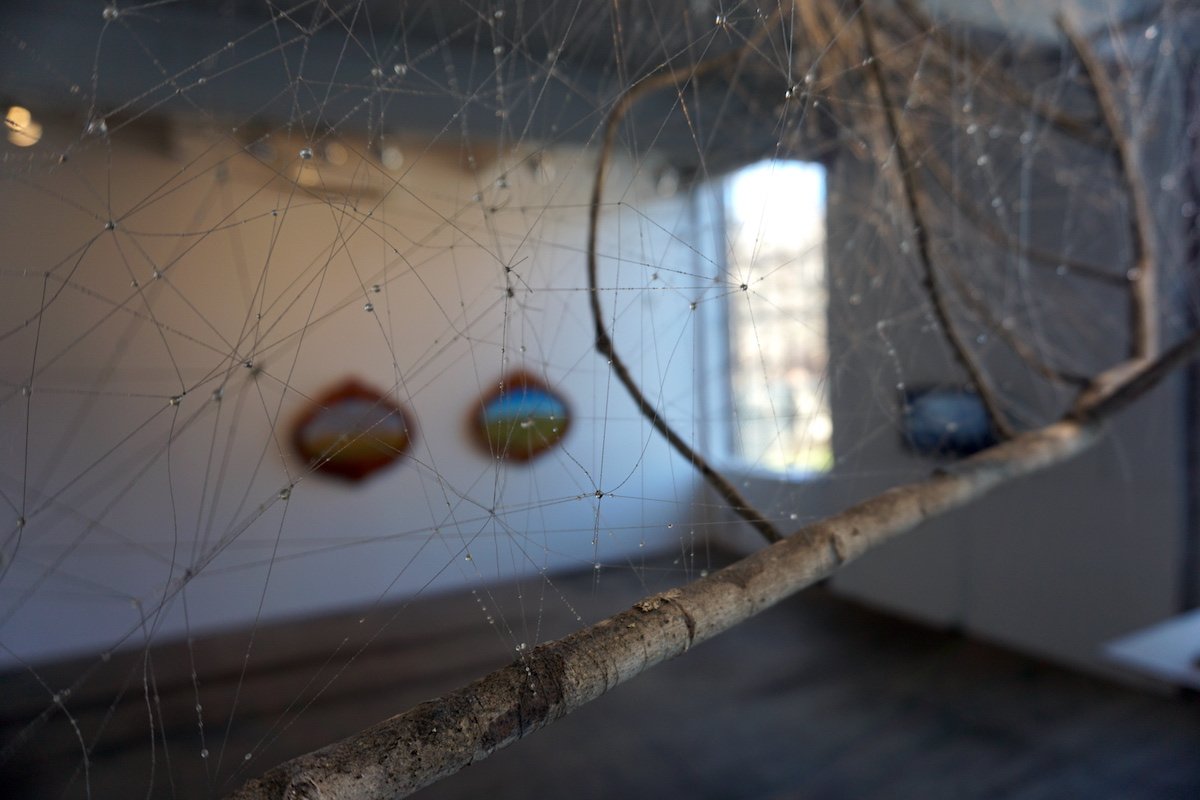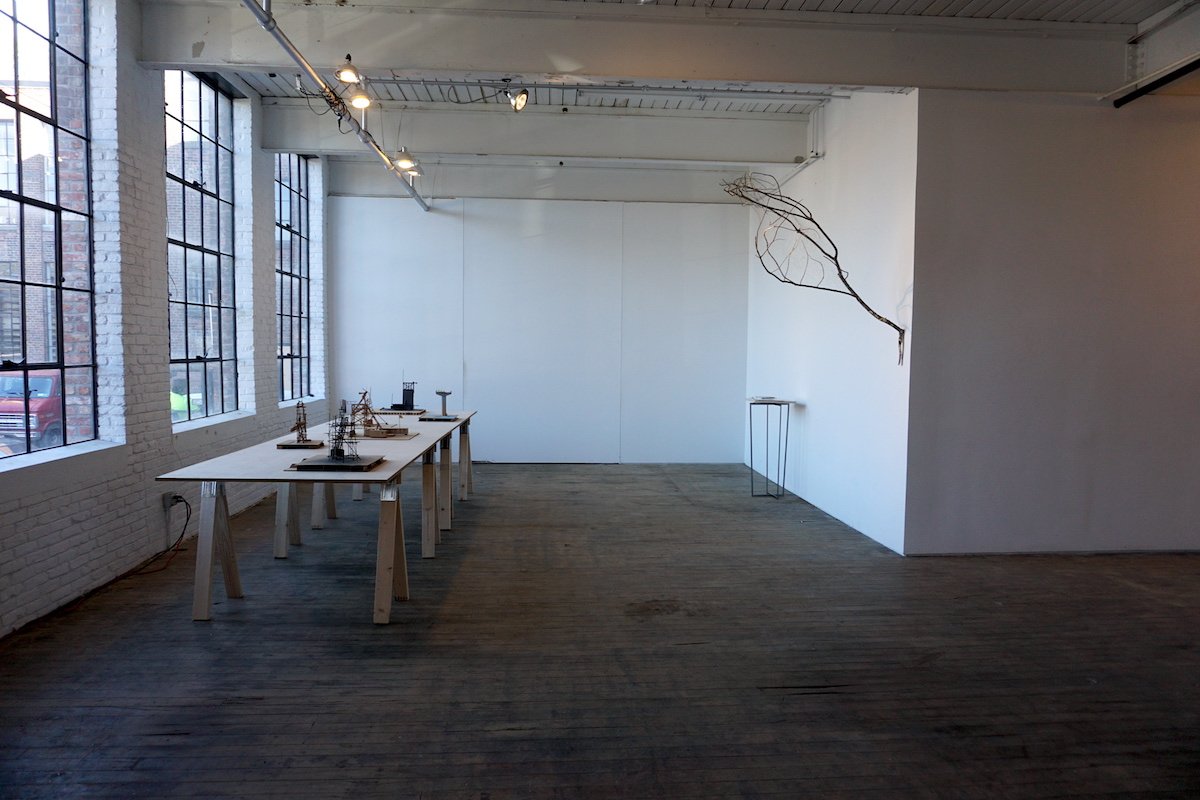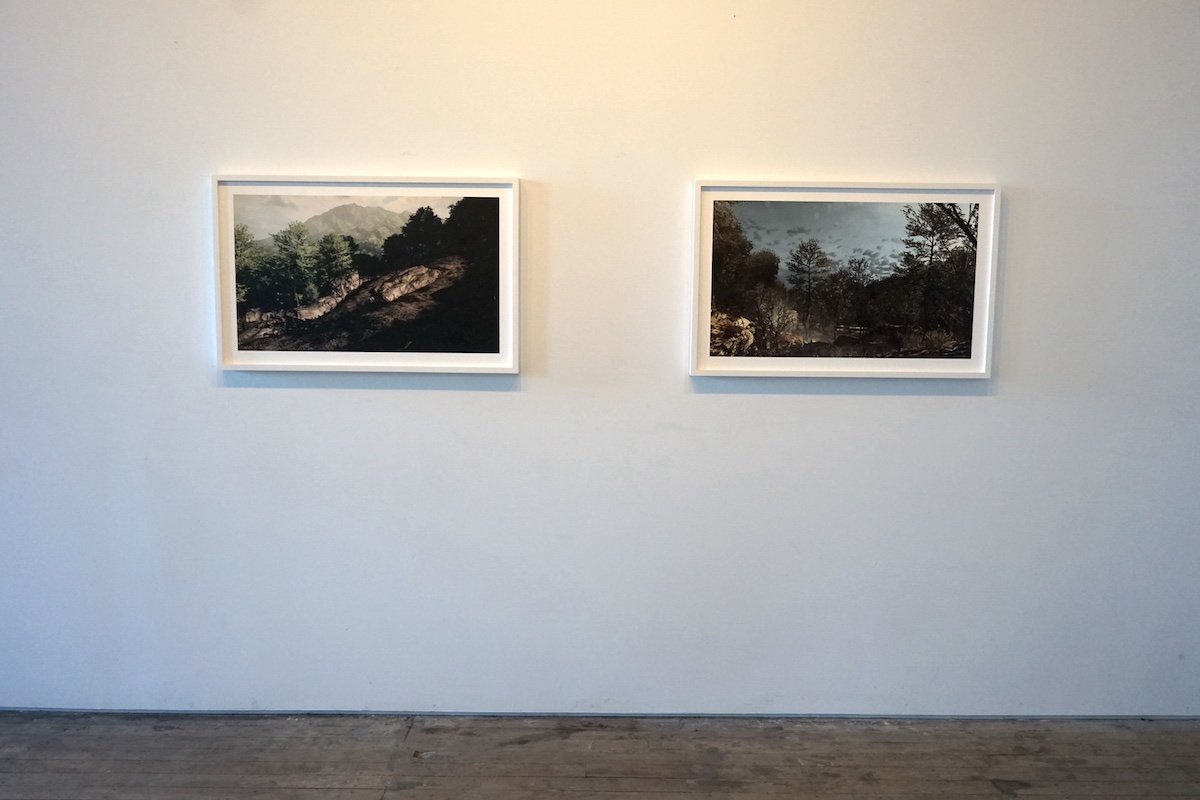Land and Time
A Momenta Art exhibition presented at
Atlas Studios, 11 Spring St, Newburgh, NY, 12250
November 4-December 17, 2017
Curated by Tal Beery and Eric Heist
Artists
Michael Ashkin, Eliza Evans, Joseph Moore, Alison Moritsugu, Sarah Cameron Sunde, Mark Tribe, Jayoung Yoon, Eco Practicum
About Land and Time
The artists in Land and Time confront monumental transformations through video, sculpture, performance, and painting, embracing time as a palpable element in their work. These artists mine forgotten histories or expose imagined landscapes, reminding us that every “landscape is not a record but a recording,” polyvalent and multivocal. Land and time are in flux, unable to be pinned down, frozen, or commodified. And yet, they reflect upon us.
Michael Ashkin’s cardboard sculptures depicting megaphone platforms built onto abandoned infrastructure reference the history of communist Appalachian coal miners seizing their means of production in the 1970s. They conjure ghosts of hope and reference the etchings of politics on the American landscape.
Eco Practicum, an artist-run school for ecological justice, presents a full day of talks and performances with Newburgh historians, anti-gentrification activists, artists, and real-estate developers. The day situates the gallery itself within Newburgh’s own land and time, using each of the works in the exhibition as a spark for further dialogue on issues of immediate concern.
In Suspect Revival, artist Eliza Evans wraps dead trees and tree limbs in heavy gauge plastic and suspends them from living trees. The embalmed forms are anchored to the ground through an intricate network of taught twine, mimicking those fungal networks that sustain live trees, but here only delay decay.
In Joseph Moore’s 24.237.237.93, a 24-hour webcam video of two polar bear worker/performers at the Anchorage zoo is compressed into a time-lapse of only a few minutes. For these animals, the zoo is an human-invented landscape offering refuge from a native habitat that is increasingly inhospitable due to human intervention.
Alison Moritsugu’s work examines how images of the land shape conceptions of the natural world. Her large-scale paintings capture what little remains of the once mighty pineapple and sugarcane industries in Hawaii, the artist’s place of birth. In Big Pineapple, fields on the Wahiawa plain are left unharvested as the land transitions to another crop; King Cane depicts the last working sugar cane plantation on Maui.
In Sarah Cameron Sunde’s 12 hour video, 36.5 A durational Performance with the Sea, a woman in a red dress faces down the immense ocean expanse as the tide rises menacingly to her neck and just as slowly recedes. This is the frail human body facing epochal change, standing witness to shifting geographies, toxic landscapes, and a warming climate.
Mark Tribe’s Rare Earth series explores the function of landscape as a symbolic setting for paramilitary fantasy. These striking photographs of landscapes found in combat video games and moving pictures shot at a militia training ground in Upstate New York depict a nature more beautiful, more real, than the thing itself - its perversion undermines conventional notions of natural beauty.
Jayoung Yoon uses hair sheared from her head to create sculptures that the artist wears and performs in as a tool for perceptual awakening. Each strand of hair is hand knotted or woven into delicate forms, conjuring invisible thoughts and memories. Her sculpture, Branch, eerily connects between a discarded tree limb and the artist’s own appendages, suggesting both the immortality of our refuse, as well as a physical merger of the mortal body with an equally mortal landscape.
About the artists
Michael Ashkin's work spans various media, including sculpture, installation, photography, video, poetry, and text. His work addresses the role of aesthetic representation in the economic and political production of space. After receiving a BA from the University of Pennsylvania and an MA from Columbia University in Middle East Languages and Cultures, he worked in the business world for eight years before choosing to become an artist. He received an MFA from The School of the Art Institute of Chicago in 1993. Since then he has shown extensively nationally and internationally including the Whitney Biennial (1997), Greater New York (2000), Documenta 11 (2002), and Vienna Secession (2009). His most recent book, Long Branch, was published in 2014. He has been awarded two Pollock-Krasner Fellowships (1997, 2012) and a Guggenheim Fellowship (2009). He is currently Associate Professor and Chair of the Department of Art at Cornell University.
Eco Practicum is an artist-run school for ecological justice, bridging the gap between learning and doing. It was founded by Eugenia Manwelyan and Tal Beery to cultivate a generation of leaders realizing visionary solutions. Eco Practicum offers place-based programs - from one-day workshops to month-long immersions - that connect participants to inspiring projects and effective experts working in the fields of environmental, social, and economic justice. Programs leave participants passionate, transformed, and ready go beneath surface meanings and dominant myths to expose the root causes and ideologies underlying our systems.
Eliza Evans’ work addresses the now permanent marriage of the mechanical and the organic, systemization and lived experience. She works with paper, construction materials, plastic, trees, rock, wire, cabling, and data to instantiate the technological mediation of everyday life and the cumulative impact of this mediation over time. Her work has been exhibited in Santa Fe, Austin and New York. She has attended residencies at Byrdcliffe and Internationale Sommerakademie für Bildende Kunst Salzburg. Before turning to art, Evans was a economic sociologist with a background in qualitative and quantitative methods, network theory, and technology commercialization. She received a BA from Oberlin College, a PhD from the University of Texas at Austin and an MFA from SUNY Purchase. Evans was raised in rural TN and lives and works in Brooklyn NY.
Joseph Moore is an artist who lives and works in NY. His conceptually based practice utilizes a variety of techniques and media, from photography to video to web and network based art. Joseph’s recent work investigates the place of the non-human animal within the context of photographic history, labor, notions of temporaility, and surveillance. His work has been exhibited in venues such as Tel Aviv Museum of Art, Tel Aviv, Israel; Microscope Gallery, Brooklyn, NY; WORM, Rotterdam, The Netherlands; Outlet Fine Art, Brooklyn, NY; Arebyte, London, England; Interstate Projects, Brooklyn, NY; The New Museum, NY, NY; and is found in such collections as The Rose Goldsen Archive of New Media Art at Cornell. Joseph is an Assistant Professor in the Art Department of The City College of New York. He received his B.F.A. from The Atlanta College of Art and his M.F.A. from Bennington College.
Alison Moritsugu was born and raised in Hawai‘i and left the islands after high school. She lives and works in Beacon, NY. Moritsugu’s work has been exhibited in solo shows at the Honolulu Museum of Art at First Hawaiian Center; Lux Art Institute, CA; Littlejohn Contemporary, NY; John Michael Kohler Arts Center, WI; and the Knoxville Museum of Art, TN. Group exhibitions include the Maier Museum of Art, VA; Palmer Museum, Penn State University, PA; Virginia Museum of Contemporary Art; Frost Art Museum at Florida International University; and Kemper Museum of Contemporary Art, MO. In 2011, Moritsugu completed a mosaic commission for the MTA Arts for Transit. She received a New York Foundation for the Arts Fellowship in painting and participated in residencies at the Cité International des Arts, Yaddo, The MacDowell Colony, and The Marie Walsh Sharpe Space Program. She received a BFA from Washington University in St. Louis, Missouri and an MFA from the School of Visual Arts in New York.
Sarah Cameron Sunde is an interdisciplinary artist and director working at the intersection of performance, video and public art. She is creator of 36.5 /A Durational Performance with the Sea (an ongoing work spanning seven years and six continents) and instigator of Works on Water (a new triennial dedicated to art that is made on, in and with the water). Sunde has served as Deputy Artistic Director of New Georges for the past 16 years (2001-2016), co-founded the live art collective Lydian Junction and the theater company, Oslo Elsewhere, and is known internationally as Jon Fosse’s American director and translator. Among other places, her work been seen at 3LD Art & Technology Center, the Knockdown Center, EFA Project Space, Rattlestick, Kennedy Center, Guthrie Theater and presented internationally in Norway, The Netherlands, Bangladesh, Mexico, China, Uganda and Iraqi Kurdistan. Residencies include LMCC Workspace, Watermill Center, Hermitage Foundation, upcoming: Baryshnikov Art Center. Honors include Princess Grace Awards in 2005, 2017, Creative Climate Award First Prize 2015, recipient of funding from Invoking the Pause, LMCC Creative Engagement, the Perry Foundation, Norwegian Consulate, Amsterdam Fonds voor de Kunst. She holds a BA in Theater from UCLA and MFA in Digital and Interdisciplinary Art Practice from City College, NYC.
Mark Tribe is an artist who works across media and forms, including drawing, painting, photography, installation, video and performance. His recent work explores the relationship between landscape and technology. He has had solo exhibitions at the Corcoran Gallery of Art in Washington, D.C.; Momenta Art in New York; Los Angeles Contemporary Exhibitions; the Queen Victoria Museum in Launceston, Australia; and DiverseWorks in Houston. His work has also been shown at Jack Shainman Gallery in New York; Ronald Feldman Gallery in New York; Yossi Milo Gallery in New York; the Palais de Tokyo in Paris; the Menil Collection in Houston; the Centre Georges Pompidou in Paris; the National Center for Contemporary Arts in Moscow; MUAC in Mexico City; SITE Santa Fe; the San Diego Museum of Art; el Museo de Antioquia in Medellín; the Blanton Museum of Art in Austin; the Telfair Museum of Art in Savannah; the Montclair Art Museum in New Jersey; the DeCordova Museum in Lincoln, Mass; and the Contemporary Museum in Baltimore. He has received grants from Creative Capital and the New York Foundation for the Arts. He is the author of two books, The Port Huron Project: Reenactments of New Left Protest Speeches (Charta, 2010) and New Media Art (Taschen, 2006), and numerous articles. Tribe is Chair of the MFA Fine Arts Department at School of Visual Arts in New York City. In 1996, he founded Rhizome, an organization that supports the creation, presentation, preservation, and critique of emerging artistic practices that engage technology.
Jayoung Yoon is a New York-based artist born in South Korea. Select exhibitions in the USA include Here Art Center, Delaware Center for Contemporary Art, Museum of New Art, Jersey City Museum, Ohio Craft Museum, and Seoul Olympic Museum of Art, Korea. She was awarded the Artist in the Marketplace program at Bronx Museum, the BRIC Media Arts fellowship, and the Franklin Furnace Grant Fund. She has attended residencies at Skowhegan School of Painting and Sculpture, Lower Manhattan Cultural Council’s Swing space, Anderson Ranch Arts Center, Sculpture Space, I-Park, and Vermont Studio Center, among others. She received her MFA from Cranbrook Academy of Art in Michigan, 2009 and her BFA from Hongik University in Seoul, Korea, 2004.
Special thank you to Atlas Studios for their generosity in making Land and Time possible.
Momenta Art's is a 501(c)3 not for profit organization that provides opportunities for emerging and underrepresented artists.
